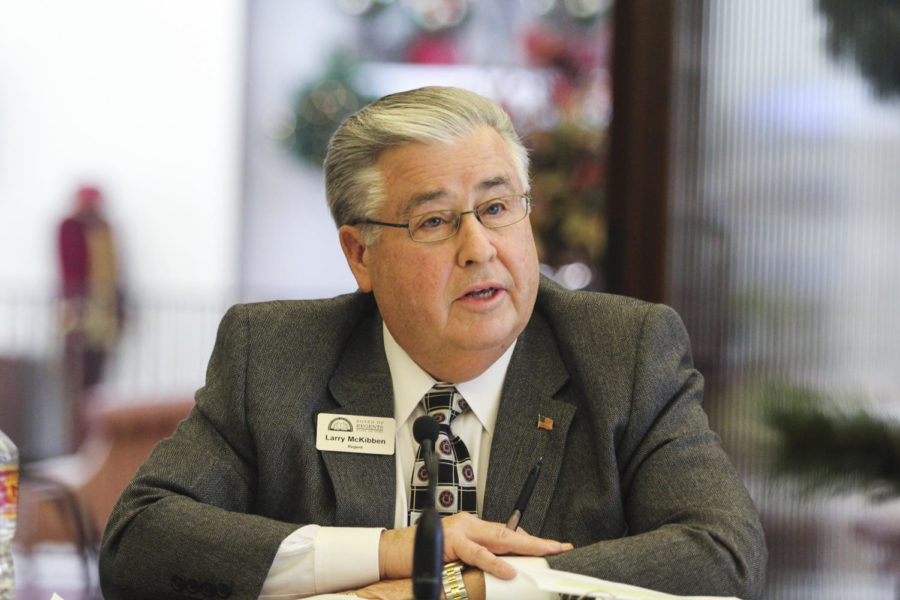International community reacts to increased tuition
Kelby Wingert/Iowa State Daily
Iowa Regent Larry McKibben advocates for a third year of instate tuition freezes for the three public universities during the Regents meeting on Dec. 3 at the Alumni Center. The Board of Regents unanimously voted in favor of continuing the tuition freeze.
January 15, 2016
As a new semester begins, questions over the recent international student tuition increase continue to swirl among students.
During the Dec. 2 meeting of the Iowa Board of Regents, tuition rates as well as fees were proposed and finalized. Amid the topics approved was an increase to international students’ annual tuitions. Incoming and returning students in 2016–17 will pay an extra $500 per year until the 2018-19 academic year, creating a total increase of $1,500 over three years.
For David Holger, associate provost for Academic Programs and dean of the ISU Graduate College, the increase represents a small change that is seen on an almost yearly basis.
“Fundamentally nothing has changed when the board approved the tuition rate. The proposal cost was based on the fact that there are additional costs in parts of the university that are associated with educating international students,” Holger said.
Holger noted the dramatic increase of international students at Iowa State, citing an 18 percent increase since 2011. He added that 11 percent of the total student population are currently international students.
“We recognize that there are additional services or capacity that we should be serving, so part of the rationale is there have been ongoing costs that we’ve just been eating from other sources in the past,” Holger said.” We also see that in order for international students to be successful there are issues that are different from domestic students, so we need to provide ways for them to have a quality experience.”
When deciding on the rate of increase for international tuition universities, the University of Iowa and the University of Northern Iowa were compared with Iowa State in order to find the most optimal balance.
At the current $29,960 estimate, the added $1,500 will essentially create a third tuition branch only paid by those who are not domestic students. With the University of Northern Iowa’s out-of-state tuition totaling an estimated $28,781 and Iowa at $37,618, the increase will put Iowa State at around a middle-ground tuition rate.
An increase of any amount, however, is never good news for international students whose home currency often fluctuates. Higher tuition can often be very strenuous on wallets, especially for those who deal with exchange rates.
“For the rest of the world, we see the U.S. dollar continue to rise, and it’s becoming harder and harder for us to come to America to study,” said Tzer Chin, senior in mechanical engineering and president of the International Student Ambassadors Club.” Back when I first came to ISU, about 50,000 Malaysian Ringgits paid for my semester, but now that cost is closer to 75,000 for the exact same amount of U.S dollars.”
Though burdening as the cost may be, for students like Chin, outrage over the tuition increase began with communication problems between those who proposed the act and students who wished to know where their funds would go.
“To me, the proposal didn’t involve international students much and went straight to the top,” Chin said. “They asked for a few opinions from us but didn’t hear much of them. As an ambassador, it’s making it difficult for students from other countries to want to come and study. They could have done a better job of explaining where our money over three years would be going exactly.”
A common complaint among the international community has been the lack of transparency as to where the money raised by the tuition will be spent and whom it will benefit. Holger claims that the money will be put back into the international community.
“There are things that we have to monitor, like full-time enrollment for international students, in order for them to keep their visa status, and that’s something we don’t have to do for domestic students,” Holger said.” Various colleges, depending on their enrollment need things like writing help centers and supplemental instruction and other advising in order for students to be successful.”
Adding to the university’s infrastructure by tactics such as hiring new professors in order to keep student-to-teacher ratios lower was also a strong argument for the additional funds.
Though these programs are essential to some students in order to be successful, students like Chin believe that using funds in this manner isn’t effective for all international bodies.
“We were told that they needed the money for programs such as teaching English as a second language, but I know for me I was taught English as my first language. I think that’s more an excuse as to them needing money,” Chin said.
The overall effect of this change won’t be seen until this fall, and as Holger states, it wouldn’t be surprising to see tuition increases in the next few years.
“The trade-off is that if we lose revenue in some areas, in order to maintain quality we need increased revenue,” Holger said. “Recently, that increase has been modest, if not frozen, for a number of years. It’s probably better for everybody to have small increases at a steady pace then to have nothing for a while and then one big increase. As costs go up we need more revenue.”







